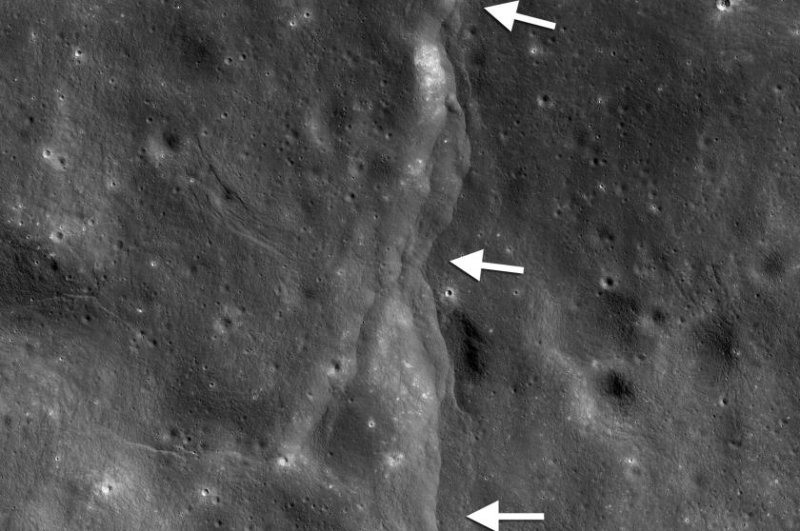1 of 2 | Thousands of images of the moon's lobate thrust fault scarps, captured by the Lunar Reconnaissance Orbiter Camera (LROC), helped reveal the patterned direction of the fractures. Photo by NASA/LRO
GREENBELT, Md., Sept. 16 (UPI) -- For millions of years, Earth has been giving its moon a massage. The effects of this massage -- the constant pull of Earth's gravity -- only recently became apparent to scientists at NASA.
For the last six years, NASA's Lunar Reconnaissance Orbiter and its array of cameras have been imaging the lunar surface at high resolution. Over the course of this survey -- still only three-fourths completed -- has discovered more than 3,000 cliffs called "lobate scarps."
These cliffs are the result of tectonic fractures created as the moon's still warm core continues to cool. As the lunar core cools and shrinks, the moon's crust buckles.
When researchers began to look more closely at these tectonic features, they noticed an odd symmetry. If global contraction alone was responsible for the scarps, the fractures should be sporadic, seemingly random in their position and alignment.
"This is not what we found," Thomas Watters, a scientists at the National Air and Space Museum, explained in a press release. "There is a pattern in the orientations of the thousands of faults and it suggests something else is influencing their formation, something that's also acting on a global scale -- 'massaging' and realigning them."
When Watters and fellow researchers compared the directions of the Earth's gravitational pull and alignment of the moon's scattered faults, they found a distinct correlation. The revelation is detailed in a new paper, authored by Watters and published in the newest issue of the journal Geology.
"Early on in the mission we suspected that tidal forces played a role in the formation of tectonic features, but we did not have enough coverage to make any conclusive statements," said study co-author Mark Robinson, a LRO scientists at Arizona State University. "Now that we have NAC images with appropriate lighting for more than half of the moon, structural patterns are starting to come into focus."
Researchers believe that as the moon's contraction creates weaknesses in the lunar crust, the gravitational tug-of-war between Earth and moon stretches the faults along predictable angles.
"With LRO we've been able to study the moon globally in detail not yet possible with any other body in the solar system beyond Earth, and the LRO data set enables us to tease out subtle but important processes that would otherwise remain hidden," said John Keller, LRO project scientist.















